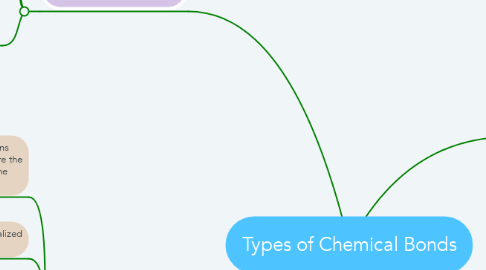Types of Chemical Bonds
par Joanna Arcelo


1. Ionic Bonds
1.1. transfer of valence electron(s) between atoms
1.2. type of chemical bond that generates two oppositely charged ions
1.3. the metal loses electrons to become a positively charged cation, whereas the nonmetal accepts those electrons to become a negatively charged anion
1.4. require an electron donor, often a metal, and an electron receiver, a nonmetal
1.5. Example of Compounds that undergo Ionic Bonds:
1.5.1. Sodium Bromide
1.5.2. Potassium bromide
1.5.3. Sodium chloride
1.5.4. Sodium fluoride
1.5.5. calcium chloride
2. Polar Covalent
2.1. a pair of electrons is unequally shared between two atoms. In a polar covalent bond, the electrons are not equally shared because one atom spends more time with the electrons than the other atom.
2.1.1. electrons are not equally shared because one atom spends more time with the electrons than the other atom
2.2. one atom has a stronger pull than the other atom and attracts electrons
2.3. Example of Compound that undergo Polar Covalent Bonds:
2.3.1. water
2.3.2. Ammonia
2.3.3. Sulfur dioxide
2.3.4. Ethanol
3. Nonpolar Covalent
3.1. there is no electronegativity difference
3.2. there is no motion of bond pair of electrons towards the bonded atoms
3.3. Examples of Compounds that undergo Nonpolar Covalent Bond:
3.3.1. Any of the noble gases
3.3.2. Any of the homonuclear diatomic elements
3.3.3. Carbon Dioxide
3.3.4. Benzene
3.3.5. Methane
3.3.6. Ethylene
4. Metallic Bonds
4.1. sharing of many detached electrons between many positive ions, where the electrons act as a "glue" giving the substance a definite structure
4.2. the valence electrons can be delocalized throughout the metals
4.2.1. Delocalized electrons are not associated with a particular nucleus of a metal, instead, they are free to move throughout the whole crystalline structure forming a "sea" of electrons
4.3. causes many of the traits of metals, such as strength, malleability, ductility, luster, conduction of heat and electricity.
4.4. The electrons and the positive ions in the metal have a strong attractive force between them. Therefore, metals often have a high melting or boiling points. The principle is similar to that of ionic bonds.
4.5. Example of Compounds that undergo Metallic Bonds:
4.5.1. iron
4.5.2. cobalt
4.5.3. calcium
4.5.4. magnesium
4.5.5. silver
4.5.6. gold
4.5.7. barium
